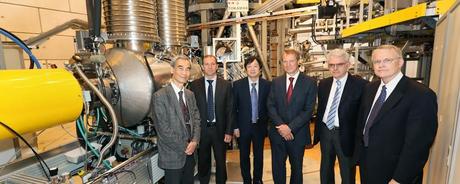 In front of the TCV tokamak at CRPP, Prof M.Q.Tran, Director General CRPP, Prof A. Fasoli, Executive Director CRPP, Prof J. Li, Dr H. Bindslev, Dr F .Romanelli, Prof J. Van Dam. (Credit: EPFL)
In front of the TCV tokamak at CRPP, Prof M.Q.Tran, Director General CRPP, Prof A. Fasoli, Executive Director CRPP, Prof J. Li, Dr H. Bindslev, Dr F .Romanelli, Prof J. Van Dam. (Credit: EPFL)In a conference on fusion research held in May by the Swiss Federal Institute of Technology in Lausanne (EPFL), Switzerland, high-level representatives of fusion research worldwide discussed the progress being made in this field. Now the EPFL has published an article briefly summarizing the state of fusion research in China, USA and Europe.
Swiss Associate CRPP, which is part of EPFL, organized the conference to present the European Roadmap for Fusion Electricity—along with comparable plans laid out in other parts of the world. About 200 people attended the event, among them mostly scientists, but also industry representatives, teachers and other interested persons.
The European Roadmap for Fusion Electricity was published by the European Fusion Development Agreement (EFDA). The document outlines how to supply fusion electricity to the grid by 2050. It also points out the need to intensify industrial involvement and to seek opportunities for collaboration outside Europe. In the course of the roadmap implementation, the fusion program is supposed to move from being laboratory-based and science-driven towards an industry- and technology-driven venture.Professor Philippe Gillet, EPFL Vice-President for Academic Affairs, opened the meeting and emphasized the importance of nuclear fusion as a safer means of energy production compared to nuclear fission. Following the 2011 Fukushima nuclear disaster, Switzerland has confirmed its commitment to fusion research while gradually stepping out from nuclear fission.
Fusion in China
Prof Jiangang Li, Director of the Academia Sinica Institute for Plasma Physics, gave an overview of the progress of fusion activities in China. There has been a formidable increase in governmental investment in recent years, which is reflected in over ten university programs for fusion physics and three theoretical centers with activities worth 40-60 million USD each year. China features a number of tokamaks for fusion research, including the Experimental Advanced Superconducting Tokamak EAST. China’s future in fusion lies in its participation in the ITER project, the construction and exploitation of the Chinese Fusion Engineering Testing Reactor CFETR, which aims to produce 200 megawatts of fusion power in the mid-2030s.
Fusion in the US
According to Professor James W. Van Dam, Director, Research Division Fusion Energy Sciences, US Department of Energy, the US holds fusion in high regard. Examples are the numerous national fusion facilities, its international partnership with the ITER project and activities such as the National Spherical Torus Experiment in Princeton University, which aims to improve plasma configurations in fusion reactors.
Fusion in Europe
Dr Francesco Romanelli, EFDA Leader and EFDA Associate Leader for JET, delineated Europe’s fusion roadmap, which focuses on providing fusion electricity to the grid by 2050. The JET Project has been successful in generating fusion power in the nineties, although not with a favorable energy balance. The key step in this roadmap is to construct and exploit ITER, in order to verify the feasibility of fusion power and then to construct DEMO, a reactor providing hundreds of megawatts of electric fusion power.
Closing the talks, Dr Henrik Bindslev, Director General of Fusion for Energy, gave an overview of the ITER project. He characterized ITER’s mission as setting standards and norms in the field of fusion and furthering its agenda by strengthening the industrial competitiveness of fusion technologies. However, he commented that ITER faces challenges ahead, especially in better understanding the behavior of hot plasma and in the selection and/or development of suitable materials that can sustain large heat loads.
Original article by Nik Papageorgiou, Yves Martin, Andrea Testa

